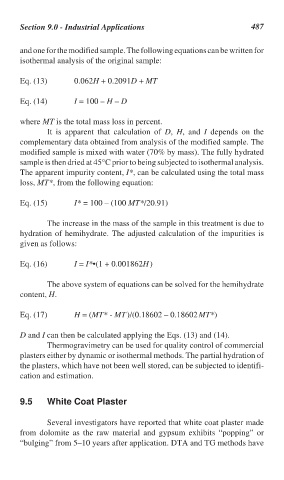Page 516 - Handbook of Thermal Analysis of Construction Materials
P. 516
Section 9.0 - Industrial Applications 487
and one for the modified sample. The following equations can be written for
isothermal analysis of the original sample:
Eq. (13) 0.062H + 0.2091D + MT
Eq. (14) I = 100 – H – D
where MT is the total mass loss in percent.
It is apparent that calculation of D, H, and I depends on the
complementary data obtained from analysis of the modified sample. The
modified sample is mixed with water (70% by mass). The fully hydrated
sample is then dried at 45°C prior to being subjected to isothermal analysis.
The apparent impurity content, I*, can be calculated using the total mass
loss, MT*, from the following equation:
Eq. (15) I* = 100 – (100 MT*/20.91)
The increase in the mass of the sample in this treatment is due to
hydration of hemihydrate. The adjusted calculation of the impurities is
given as follows:
Eq. (16) I = I*•(1 + 0.001862H)
The above system of equations can be solved for the hemihydrate
content, H.
Eq. (17) H = (MT* - MT)/(0.18602 – 0.18602MT*)
D and I can then be calculated applying the Eqs. (13) and (14).
Thermogravimetry can be used for quality control of commercial
plasters either by dynamic or isothermal methods. The partial hydration of
the plasters, which have not been well stored, can be subjected to identifi-
cation and estimation.
9.5 White Coat Plaster
Several investigators have reported that white coat plaster made
from dolomite as the raw material and gypsum exhibits “popping” or
“bulging” from 5–10 years after application. DTA and TG methods have

